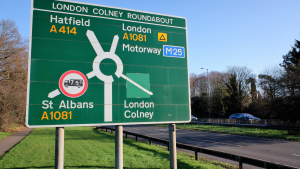We’re all familiar with the central white lines that we see on most roads, but less of us know about the differences between the types of white lines. Did you know that they can vary from road to road? Well, we’ve put together a handy guide that shows you the difference between some of the more common forms of central white lines.
Table of Contents
Lane line
If you’re travelling on a dual carriageway or a motorway, you’ll be familiar with a lane line. These are distinguishable by the fact that the traffic on your side of the road will all be travelling in the same direction. The road markings on lane lines are made up of short white dashes with long gaps in-between.
Central broken white line
This is the most common form of white line that you’ll find as it’s on most single carriageway roads. The central broken white line is made up of longer dashes than a lane line with shorter gaps in-between. Used on single carriageways, it signifies roads where the traffic is travelling in opposite directions either side of the line.
Hazard warning line
Like the name of the line suggests, the hazard warning line will alert you to an upcoming hazard such as a sharp bend or a junction where you’re going to have to come to a stop. With hazard warning lines, you’ll notice that they will replace either a lane line or a central broken white line as you get closer to a potential hazard. The difference between hazard warning lines and the others is that the hazard warning lines are much longer and have shorter gaps in-between them. Also be on the lookout for signs that could alert you to the upcoming hazard.
Solid double white lines
Double white lines are there to notify drivers of a hazard and to let them know that overtaking is not permitted. Most of the time, crossing a solid white line is illegal, there are however a few exceptions to the rule. You are allowed to straddle or cross the line if you need to manoeuvre around a stationery vehicle, enter a property or a side road, overtake a cyclist, overtake a road works vehicle that is travelling at less than 10mph or overtake a horse.
If there is one solid double white line and a broken line closest to you in the middle of the road then you are permitted to overtake as long as you can complete your manoeuvre before the broken line becomes solid again.
For more useful driving theory information, check out our Learning Centre





